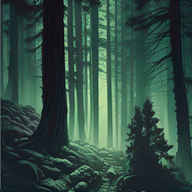The plant life of the Crescent Forest has adapted well
to this heat. Many of the segmented conifers that are
found in the Forest Ridge are also found in the Crescent
Forest. However, the enormous palm fronds which blanket
the Forest Ridge are much less common here.
The fanna trees are tall and thin, with a dense network
of leaves and branches only at the very top to catch the
sunlight. The leaves are narrow even when open, and fold
to thin slivers in the heat of midday. Beneath the canopy
of thin leaves lies a scattered patchwork of smaller brush
of a variety of species.
The soil is loamy and soft, and often carpeted with
a blue-green moss called berill. This moss retains water
and holds the soil together. In open clearings during the
season of high sun, berill dries to a thin shell which
crackles when stepped upon; in this state it is edible (with
a flavor like dried tea leaves).
There are many species of plants found only within the
Crescent Forest, so far as anyone of the Tyr region knows.
Travelers can find a number of wild fruits and nuts
within the Crescent Forest. Welela plants provide a long,
thin, prickly gourd whose meat is flavorful and contains a
fair amount of water. Welela plants are cultivated outside
of Gulg, but they can also be found throughout the
Crescent Forest. Geja, on the other hand, is a soft-skinned
fruit which is only ripe for a few days each year, and most
of its fruit quickly falls prey to insects. If it can be picked
and eaten fresh however, it is sweet and delicate. Geja
can be dried in the sun, in much the same way one can
dry dates. Geja retains much of its sweetness when dried.
The kola nut, which is heavily cultivated by the slaves of
Gulg, is ground into a fine powder which, when steeped
in water, creates a tasty beverage which stimulates the
mind and wards off sleep.
The blue agafari tree is among the most striking of
the plants in the Crescent Forest. Its spreading branches
provide shade and shelter in the forest; indeed, the palace
of the oba Lalali-Puy in Gulg rests upon the limbs of
a huge agafari. Its wood is nearly as hard as bronze
and makes excellent weapons and shields. In Nibenay,
its straight limbs are sharpened and used as lances for
the Shadow King's half-giant army. Agafari nuts are
edible and its leaves may be used for ticking. The tree is
incredibly hardy and its wide trunk can be hollowed out
without killing the tree.
The only hazard one might encounter when traveling
among agafari trees lies in the bloodvines which live on
their bark. These vines are as thick as a man's finger and
tightly root themselves to the bark of a tree. Sometimes
they can coil themselves around the base of a tree, completely obscuring the trunk. In addition to being a
physical nuisance, these vines can inject their roots into
anything living which touches them. This causes intense
pain and, if the contact is prolonged, even death. The
slaves of Gulg spend much of their time keeping the
bloodvines off the agafari trees in the city. The bloodvines
are so common on agafari trees that some believe they
are actually part of the tree, rather than a parasite living
on it. A more aggressive carnivorous vine is the strangling
vine, which can be found in the more remote areas of the
Crescent Forest. These plants are found draped between
several trees, usually over a footpath or trail. The vine lays
motionless until suitable prey passes beneath it. The vine
then drops to its victim, buries its thorns deep the victim's
neck, and then strangles the victim by yanking them off
their feet, kicking and screaming. Travelers should also
beware of the giant sundew, which is a creature with the
appearance of a mound of ropes covered with gray-green
tar. This plant can cast its tendrils several feet, burning
its victim with an acidic touch.
The forest is also home to the carnivorous plants
found across the Tablelands. Blossomkiller, dew fronds,
poisonweed, and zombie plants can all be found in the
Crescent Forest. While none of these are common, travelers
should be aware of the dangers which they present.
The fauna of the Crescent Forest is as varied as
the plant life. There are a number of large carnivores,
including crystal spiders, tembo, zhackal, and even the
occasional gaj.
Perhaps the most amazing aspect of the wildlife within
the Crescent Forest is the wide variety of birds. There are
hundreds of species, each brightly plumed and with its
own distinctive call. Some birds in the Crescent Forest,
like the yellow-plumed rhoss, can be trained to mimic the
speech of humans. The red and green kvale, can actually
recall melodies that it hears. Many of the children's songs
of Gulg imitate the call and response of the kvale.
The lumber camps of Nibenay have recently reported
sighting a behir in the forest. It will not be the first time
that the woodcutters have had to deal with a predator
whose territory they have encroached upon. Based upon
description, it seems that the beast must have made its
home in the Crescent Forest for centuries. The woodsmen
have heard that behir have devastating psionic abilities.
Templars assure them that a behir's low intelligence would not allow it to use such abilities very effectively. Some
templars have suggested that the sightings may just be the
result of a druid causing trouble.
